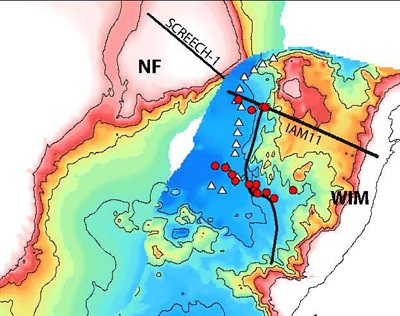Nov
9
A New Way To Find Oil And Gas Is Proposed
November 9, 2010 | 1 Comment
Scientists from Royal Holloway, University of London and the Institut de Ciencies del Mar, aka The Spanish Research Council have revealed a new model that explains what happens as the continents thin as well as helping to more accurately predict the location of hydrocarbons such as oil and gas. The scientists offer a new way to prospect and discover oil and gas.
Early as the crust comes apart, the cold continental lithosphere thins and subsides or sinks deeper into the earth, creating rift basins. If the crusts thinning continues to final break-up, the split and greatly thinned plates subside deep below sea level to form a conjugate pair of rifted margins.
The pair of scientists used depth-migrated seismic images to accurately measure fault extension, the coming apart of the crust, and compare it with the crusts thinning. The observations are used to create a balanced kinematic model of rifting that resolves the extension discrepancy by producing both fault-controlled crustal thinning which progresses from a rift basin to the asymmetric structure, and extreme thinning of conjugate rifted margins.

Iberian Peninsula Seen 120 million Years Ago. Black lines are seismic profiles. The graphic shows the result of the research tracking back of faulting. Click image for a the largest view.
Now for oil to be formed, sediments need to be deposited under the right temperatures. “When continents extend, the top of the crust subsides and deepens, creating a space for sediments which may convert into oil,” explained Dr Marta Pérez-Gussinyé from Royal Holloway. “Our model presents a conceptual framework to predict more accurately the temperature conditions through which sediments go, therefore helping in the search for oil and gas.”
Geologists have long debated the paradoxes arising from their various understandings of how continents break apart and drift forming new oceans. Many continents, such as Africa, parts of South and North America, Europe, Asia and Australia, are surrounded by rifted margins, which are the stretched areas where the geological processes of rifting and break-up are recorded.
Here’s the important part: It was previously believed that as the Earth’s plates drifted away from each other the rocks in the stretched area broke up by faulting all at the same time. The new concept is that, in fact, the faults form one after another in this region as the crust thins. As the faults are forming, sediments are deposited and the youngest ones are found closest to the new oceans that eventually form.
The new model is based on high-resolution images of the tectonic structure of the crust at such margins. These images are obtained using elaborate seismic methods, which give a picture of the crust below the oceans, showing where faults and sediments are.
The new model has important implications for the formation of hydrocarbon resources, plus it offer a new view of the style of faulting during continental thinning, sediment deposition and potentially for the opening of oceanic gateways and oceanic circulation.
The scientist’s paper appears in the Nov. 3 edition of Nature.
For those worried on the peak oil front the new way to understand the deep underground formations is going to be a salve, well, a little anyway. The scientists don’t directly say so, but there is oil and gas formation occurring all the time, albeit very slowly. The new work offers a view on where to drill and have a look.
What might be of the greatest significance, assuming that the political climate for petroleum research and discovery gets more healthy, is the new technology would offer mankind a new way to get an inventory of where the oil and gas might be found. Practice; with information from already drilled resources now might bring considerable surprise to the amount of undiscovered petroleum reserves.
This is but just a new first level of the deepening understanding of the formation of petroleum. One other addition among many would be to identify where the sediment deposition was best in organic flows such as an ancient river depositing as the Mississippi does now.
Maybe modern man has found all the petroleum – an idea popular with the oil doomers. But realistically, lots of petroleum is in the inventory now, and there has to be much more yet to find. The earth is such a carbon rich place – there must be more – its just a matter of finding it.
Comments
1 Comment so far


Great information! I’ve been looking for something like this for a while now. Thanks!